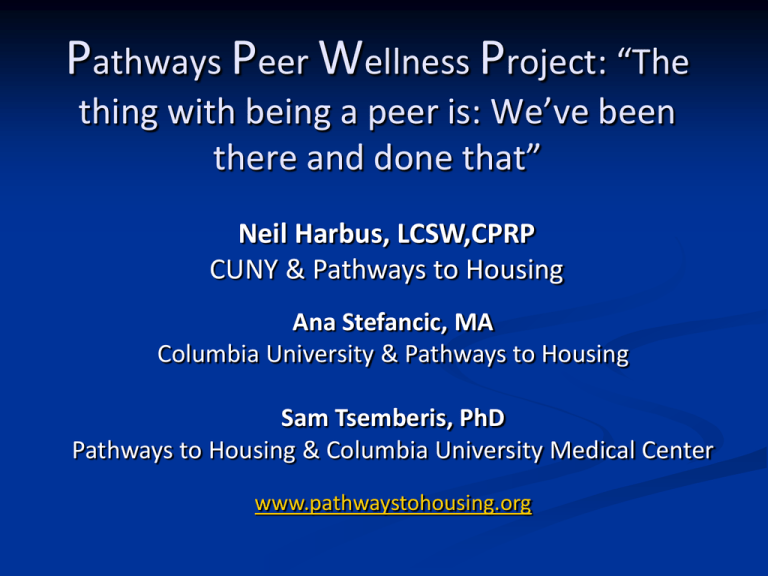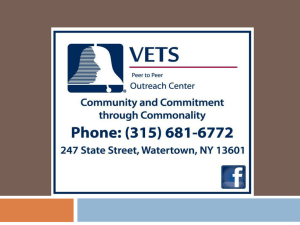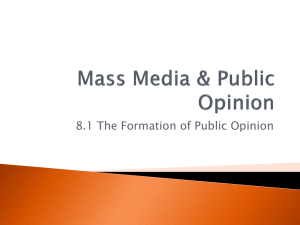The Peer Wellness Program
advertisement

Pathways Peer Wellness Project: “The thing with being a peer is: We’ve been there and done that” Neil Harbus, LCSW,CPRP CUNY & Pathways to Housing Ana Stefancic, MA Columbia University & Pathways to Housing Sam Tsemberis, PhD Pathways to Housing & Columbia University Medical Center www.pathwaystohousing.org Peer Wellness: Program Overview Funded by Substance Abuse Mental Health Services Administration (SAMHSA) Grant expectations: 570 individuals will receive Peer Wellness services over 5 years (now in year 2) 11 Peer Wellness Specialists hired as part-time employees (approx 5.5 FTE) All Pathways consumers are eligible. Participants are referred by support teams, peers specialists or through self-referrals Who Are Our Target Populations? Individuals in the process of transitioning off of Pathways’ ACT Teams Individuals who are looking for assistance in planning the next step in their Recovery process. Individuals who are new to Pathways, and could benefit from peer support during this time. Individuals who have become disengaged from their Team. Who are the peer specialists? “A peer is someone who’s been where you been and a specialist means they got training to help you better.” Mental health Substance use Homelessness Criminal Justice … Wellness Services Providing “consumers with information, skills and strategies to self manage mental health challenges and to engage in recovery supporting actions”* Tools/EBPs: Wellness Self-Management (WSM, IMR-derived) Wellness Recovery Action Plan (WRAP) Relapse Prevention Plan Supported Employment Program Specific: Balanced Life, Healing from Within, etc. *Center for Practice Innovations, Columbia Psychiatry Training, Supervision, Documentation Training 3 day orientation: Program Overview, Wellness and Recovery principles, Intentional Peer Support, Trauma Informed Care, Crisis Response, Safety, Documentation, Engagement Techniques, WRAP, WSM and other Recovery Curricula Ad hoc trainings: Stages of Change, Motivational Interviewing, CBT Supervision Bi-weekly group supervision: clinical & administrative issues/questions + successes In-vivo Field supervision & Support Ongoing review of progress notes and edits Documentation: Peers complete progress notes in electronic record on same day of service (agency standard) Flexible Service Delivery Location of Services: Consumer’s apartment, in the community, in their team office, at the Resource Center Format: One to one or group format. Whatever works best for the individual Specialties & Caseloads: Apart from general Wellness, many peers have a specialty: Employment, Education, Finances Peers have caseloads but can refer consumers to others for specialty services Two Structural Modalities: Peer Specialists Embedded on Assertive Community Treatment (ACT) or ICM Team Peer Specialists at Resource Center Flexible Service Delivery Primary Base: ACT Team (4) Work alongside clinicians, etc. Attend morning meeting Visit clients in the community Enhance quality of services, not replace existing services One-on-one or group sessions Primary Base: Resource Center (7) All services are peer-led Facilitate classes and groups One-on-one counseling sessions Visit clients in the community Develop program curricula All 11 peer specialists are “linked” to one of 9 teams (spread over 6 geographically dispersed areas) to facilitate referral, service delivery, and communication Pathways Resource Center Open 6 days a week, the Resource Center offers upwards of 25 Peer-led Recovery Classes a week including: Nutrition Class including cooking and gardening WSM and WSM plus Healing from Within Photography Art Financial Wellness Life Balance Filling a Man’s Shoes Going Broke for a Smoke Parenting Support Group Harm Reduction Journaling 2 Computer Classes 2 Continuing Ed/College Prep Classes My Neighborhood, My World Women’s Issues Work Now WRAP Group Science History Journaling Harm Reduction Moving On Group * A number of these groups are also offered at other Pathways’ sites* Peers Enhancing Services Average contact is close to an hour Spend quality time with individuals focusing on wellness and minimizing “case management” functions Increasing monthly contact with consumers: Served over 170 individuals since start-up (varying levels of service intensity) Averaging 240 contacts a month Increasing community contacts with a variety of services being offered Contributing to the overall stability of individuals, which leaves the Team with more time to focus on immediate crises Reengaging and reestablishing working relationships with individuals on behalf of the Teams Targeted Wellness Domains Environment: Housing, Safety Checkups/Screenings Managing Chronic Illness Nutrition & Exercise Social: Family Reconnection, Friends/Partners, Loss Intellectual: Financial: Entitlements, Financial Empowerment Occupational: Leisure pursuits, employment activities, Job training Emotional/Mental Stress Reduction Symptom Management Medication Substance use GED/College Prep Physical: Spiritual: Meaning and Purpose Values, Code of Conduct Process & Outcomes Evaluation Consumer Outcomes: Interviews with participants at intake and every 6-months thereafter Quantitative: Functioning, Social Activities, Employment, Recovery Qualitative: Goals, next steps, what’s helped and what hasn’t Process Evaluation: Peer specialist interviews Qualitative: Peer role, challenges, successes… Sample Outcomes Client Perception of Functioning: improved 24% over baseline Employment: improved 11% over baseline. This includes a dozen people securing either competitive or transitional employment positions. Social Connectedness: improved 11% over baseline Skills Enhancement: 27 Individuals worked on developing positive strategies to reduce the harmfulness of behaviors that interfere with their wellness, including substance use. 15 individuals were observed to have enhanced their computer skills. 15 individuals worked on enhancing their understanding of healthy cooking and nutrition. Outcomes Clinical: 3 individuals were assisted in transitioning from ACT services to a less intensive level of care, 25 individuals reported enhanced social relationships and family reconnection. 30 individuals reported improved medication adherence. Case Examples 12 psychiatric admissions/ER visits in 14 months before working with peer wellness program No contact with daughter for over 20 years Case Examples From 12 psychiatric admissions/ER visits in 14 months to 0 admissions/ER visits in 12 months+ post-enrollment From no contact with daughter in 20+ years to… Peer helped him open an e-mail account, open a Facebook account and found her on Facebook. She lives overseas & they’re arranging a meeting in the U.S. Sample Note This was the first time that I spoke with B. Peer introduced index cards to B. in order to find out what goals he wanted to work on. B. decided that he wanted to stay out of the hospital, go back to school, and get his own apartment. B. talked about how he was depressed. Peer asked why was he depressed. B. stated that he felt hurt and pain, and it consumed his whole body. B.’s mother stated that he was heart broken over different women. B. then showed me pictures of different women, and talked about how they hurt him. Peer suggested to B. that maybe at this time he can focus on his goals and not concentrate so much on different women that may hurt him. B. then agreed and said this is true. Peer talked about the Wrap Plan and suggested different ways B. can cope with stress and depression. Peer suggested that B. could use Wrap Plan techniques like listen to music, or meditate, or take walks. B. stated that he was depressed and didn't feel like doing anything. Peer encouraged B. to try and use some techniques. B. stated that he will try. Peer stated to B. that we will be working with the WSM Workbook and doing different Lessons. B. stated ok, he just wants someone to work with him and understand him. Peer assured B. that I will work with him and help him to better understand what’s going on with him. B. stated okay. Peer will follow-up on… Consumer Interviews What’s Changed Since Being In the Program? What’s Helpful about The Program? “ I want to become a Peer Specialist” “ I got an apartment, I have more privacy, I’m more alert, I have better concentration” “I’m Focusing on School” “I got a job” “It Helped Me Bridge The Gap Between Who I Was And Who I Was Becoming” “They brought me Hope!” “I’m learning and exploring new things” “They helped me with my medical problems” “ I grew a lot, I became a better person” What Did People Most Report Was Missing From Their Lives? A Partner A Job Visitation with their Children or having their Children returned to them *We will soon be starting a parenting initiative* Peer Specialist Perspective: Bumps In The Road Selling a New Program is always a Challenge: “There are some individuals who have been so knocked down and beaten up, decades and decades and decades, that they don’t trust anybody. And a lot of them…they been so beaten down that they don’t think- they don’t feel that they’re worth even talking to to see what is goin’ on with them.” Gaining Full Acceptance from “Professional” staff: “And there are people from counselors on up to the clinicians who are not willing to accept us. Either they think we’re tryin’ to step on their toes, they think we’re tryin’ to take their jobs, or they think we’re tryin’ to be them.” Bumps in the Road Gaining Full Acceptance from Pathways’ participants: “I’ve had- one or two people who uh, didn’t want to accept my, my services, or me, solely because I was a peer, and not a professional.” Managing one’s own wellness “Sometimes I have to drop appointments and- and I’mI’m only one person, and my wellness comes first and foremost.” Peer Specialist Perspective: Successes Making a Difference “I asked him if he just wants ‘em to increase the Seroquel and that’ll do it. And he said, no, it’s the Seroquel and the program. So, that makes me feel like, you know, I’m playing a part, and it’s not just the Seroquel.” Advocacy/Mediation “My job is to advocate for the consumer. That’s my job first and foremost. There for employment, to make sure these guys are afforded their rights. And if Pathways is supposed to be doing something for them? It’s my job to make enough noise so that it’s done.” Sense of Community “The camaraderie with the co-workers, the consumers, the environment…walking here is like walking home.” Thank You! If you are interested in bringing Peer Wellness Services to your agency contact: Neil Harbus nharbus@pathwaystohousing.org Also, Presentations at Housing First Partners Conference New Orleans, March 21-23, 2012




